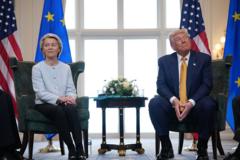The trade agreement between the European Union and the United States, heralded just days ago by European Commission chief Ursula von der Leyen and US President Donald Trump, faces significant scrutiny from European leaders. Initially celebrated for averting a 30% tariff threat from Trump, the deal instead introduces a 15% tariff on most EU exports to the US, a stark increase from the previous average rate of 4.8%.
While some leaders like Germany's finance minister Lars Klingbeil acknowledged the agreement as a necessary step towards certainty in business operations, dissatisfaction looms over the terms. "I would have wished for a different outcome," he stated, indicating a desire for stronger negotiation tactics.
The deal's announcement has since revealed numerous unresolved discrepancies between the two sides. The European Commission stressed that the agreement is not legally binding but rather a collection of political commitments to forge future negotiations. On the other hand, the US portrays it as a monumental achievement, with Commerce Secretary Howard Lutnick confirming that talks would continue to finalize various aspects.
European leaders, including French President Emmanuel Macron, have cautioned that this is merely the beginning, urging for a firmer stance from Europe in future dealings. The agreement notably allows for tariffs on key sectors, with pharmaceuticals and semiconductors facing potential hikes despite the EU's insistence on maintaining a 0% rate for now. Germany, Ireland, and Italy, in particular, stand to face steep financial impacts due to their trade dependencies with the US.
The potential consequences extend beyond immediate tariffs; disagreements over investment commitments and defense spending further complicate the situation. The EU's vague language around purchasing US military equipment contrasts sharply with the US's definitive statements, highlighting challenges in alignment.
As negotiations progress, the pressing question remains—who will emerge as the real winners and losers of this trade deal? The distinct economic fallout for various EU countries, coupled with the mixed reactions from political leaders, underscores the complicated landscape of transatlantic trade relations moving forward. As discussed by Cinzia Alcidi of the Centre for European Policy Studies, while the blanket 15% tariff might provide temporary certainty, deeper negotiations will be essential for looking ahead.



















